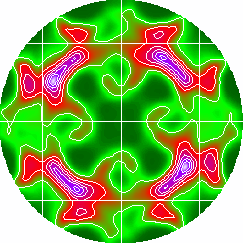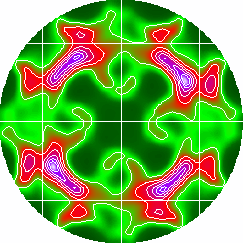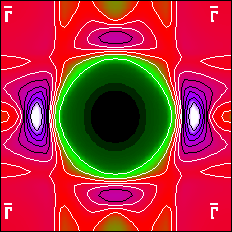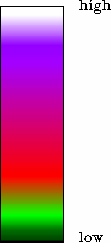Intensities of ultraviolet photoemission into the full hemisphere have been
calculated for the first time within the one-step model. Compared to the
usual consideration of only very few emission angles, a wealth of information
is accessible now. The angular distribution
allows to value the importance of various spots, their mutual relevance, and
to observe connections between them. Such intensity maps of photoemission
have already been measured in the last years and are quite common
for experimental and theoretical X-ray photoelectron diffraction.
The special interest in the ultraviolet photon regime results from its
sensitivity to valence electronic structure.
 |
 |
Fig. 1: Photoemission intensities from Si(001)1x1 at a
final state
energy of 30 eV and initial energies from -1.8 eV to
-2.2 eV. The normal incident light is left circular polarized.
The grid shows the reciprocal surface lattice with the surface Gamma
points at the
crossings. The intensities of the emissions into the full hemisphere
are projected onto the corresponding wave vectors. |
Fig. 2: The same as in Fig. 1 but for right circular
polarized light. This resulting rotation of intensity is similar to
those obtained from circular dichroism in X-ray photoelectron
diffraction patterns. For the colors see Fig. 4. |
The calculation for the Si(001)1x1 surface considers polarization effects.
Circular dichroism is the difference of the intensities
for left circular polarized light and right circular one.
In core level photoelectron spectroscopy such investigations recently
have found interest also for non-magnetic
materials. Especially, an azimuthal peak rotation is
identified. Those results form
the original motivation of this work, i.e. to investigate the valence band
spectra and to look for evidence of the same mechanism in this energy regime.
Surely, one cannot expect simple results as
in the core level photoemission, because the overlap of wavefunctions of
different orbitals will deteriorate the picture of one definite angular
momentum in the initial state.
However, in the chosen example such a azimuthal rotation occurs.
Going from Fig. 1 to Fig. 2 one seemingly detects a
clockwise peak rotation. The angle of the rotation is hidden since
the regions of high surface density of states (SDOS) bound the
appearance of photoemission peaks.
 |
 |
| Fig. 3: Surface density of
states (SDOS) in one cell of the reciprocal lattice. |
Fig. 4: Color scale for the intensities of the
photocurrent and the surface density of states. |
The SDOS of the 4 uppermost atomic layers is
plotted in Fig. 3. The energy interval
of (-2.2,-1.8) eV covered in this figure contains mainly px and
py orbitals. The mesh drawn in Figs. 1 and 2
corresponds to the reciprocal lattice of the surface parallel planes, i.e.
the SDOS of Fig. 3 is related to a single square of this lattice mesh. In
Fig. 1 and 2 one finds that the photoemission intensity is clearly
associated with the SDOS. The corresponding emissions near the pole are
lacking, because of the chosen perpendicular incidence of light.
See also:
Acknowledgment:
This work was supported by the Bundesministerium für Bildung,
Wissenschaft, Forschung und Technologie.
|


![]()
